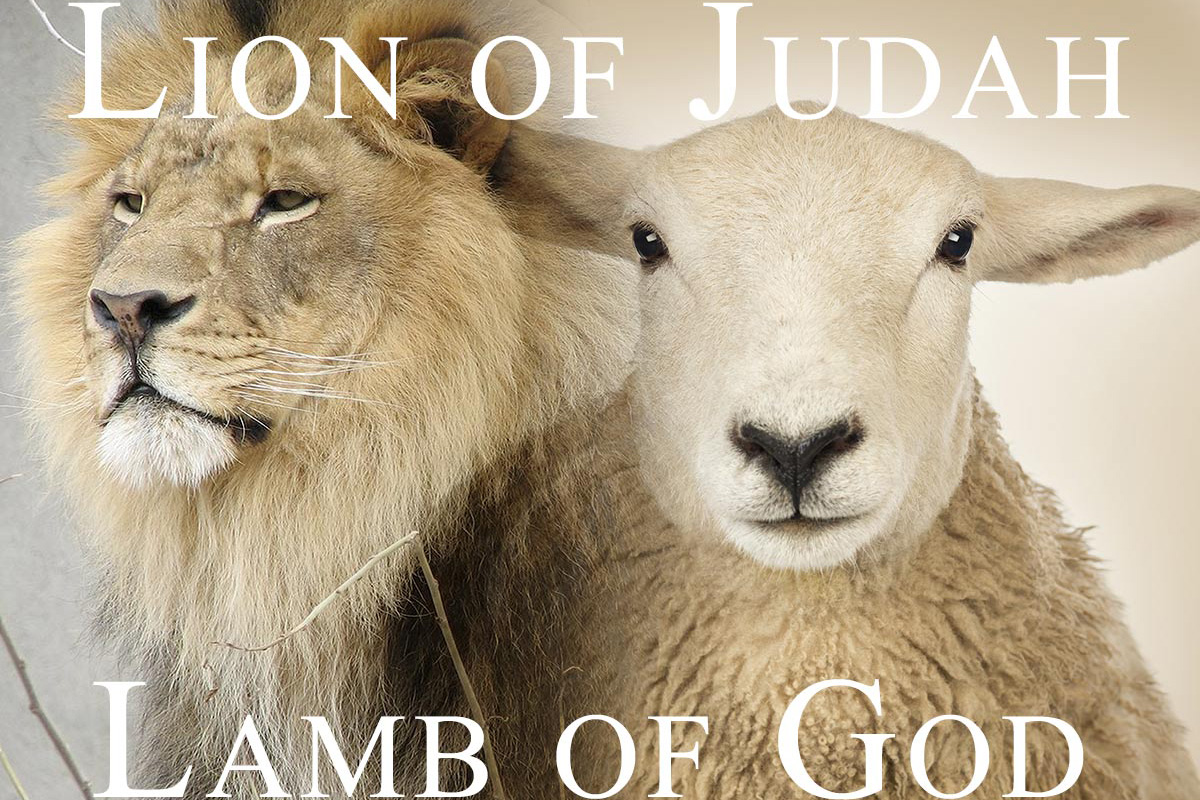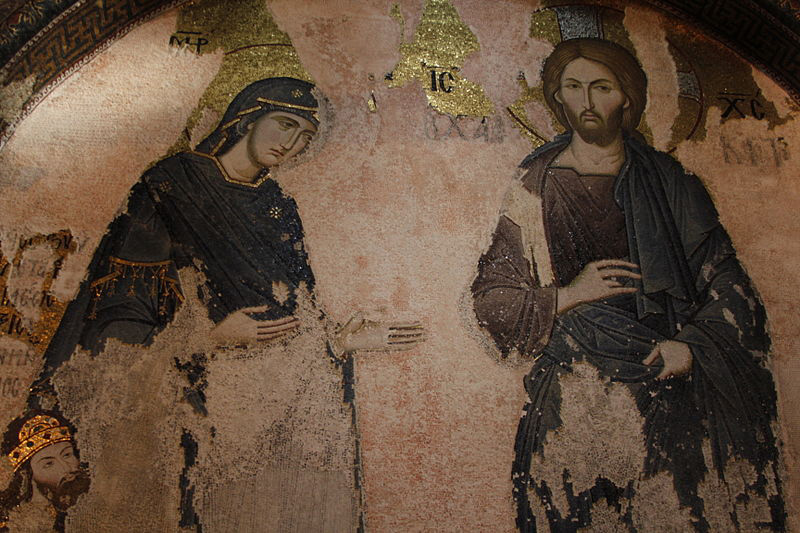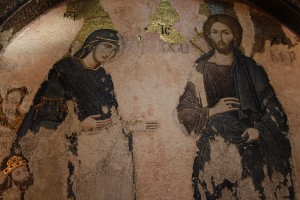 As Ordinary time (tempus per anum) opens up, the lectionary continues to “introduce” Christ to us. Last week he was baptized obtained many gifts for us as he was manifested by the Father.
As Ordinary time (tempus per anum) opens up, the lectionary continues to “introduce” Christ to us. Last week he was baptized obtained many gifts for us as he was manifested by the Father.
This week is a continuation of sorts as John the Baptist elaborates on Who Jesus is. John’s words are brief but they are packed with Christological teaching. In this Gospel we learn at least five things about Jesus. He learn that he is prefigured, preexistent, preeminent, powerful and the presence of God. Let’s look at each one.
1. Prefigured – The text says, John the Baptist saw Jesus coming toward him and said, “Behold, the Lamb of God, who takes away the sin of the world. Now, unless you know the history of this moment, it seems a little odd. A full grown man approaches John the Baptist and he says, Look! There is the Lamb of God.
But for those who know the scriptures John is really answering a question that was asked by Isaac some 1800 years prior to this event. Abraham has received from God a strange and terrible command that he take his son to Mt. Moriah (present day Jerusalem) and there offer him in sacrifice. As they arrive at the foot of Moriah, here is where we join the Genesis text:
And Abraham took the wood of the burnt offering, and laid it on Isaac his son; and he took in his hand the fire and the knife. So they went both of them together. And Isaac said to his father Abraham, “My father!” And he said, “Here am I, my son.” He said, “Behold, the fire and the wood; but where is the lamb for a burnt offering?” Abraham said, “God will provide himself the lamb for a burnt offering, my son.” So they went both of them together. (Gen 22:6ff).
Do you get it? A promised son has wood laid upon his shoulder and is made to carry it up a hillside, the same hillside where “Golgotha” will one day be found. There, on the top of that hill he is to be laid on the wood and killed. Sound familiar? Of course, it is a prefigurement of Christ, or a “type” of Christ. Things are starting to look grim for Isaac who gets nervous and says, “Daddy – where is the Lamb?” You know the rest of the story. It is true that there was a ram caught in the thicket which God provided that day, but that ram pointed to Christ.
And so the question, “Where is the Lamb?” wafted up on the breeze and got repeated down through the generations. Some five hundred years later at the end of the Egyptian slavery the blood of the lamb also protected Isaac’s descendants from death. And every Passover the question was still asked, where is the Lamb, referring to the Passover lamb. Here too, the Passover lamb was but a symbol, a prefigurement of Christ.
Now, standing on the banks of the Jordan John the Baptist answers Isaac’s question repeated down through the centuries: “Where is the Lamb?” “Look! There is the Lamb of God!” So the first thing we learn of Christ is that he was prefigured, here and in many other places in the Old Testament.
2. Preexistent – The text says, He is the one of whom I said, ‘A man is coming after me who ranks ahead of me because he existed before me.’ Now this too is a strange thing for a man to say about his younger cousin. Jesus was born six months after John the Baptist, yet John says, he existed before me. But John is clearly teaching us here of Christ’s pre-existence. Before his assuming a human nature, Jesus existed eternally with the Father. There never was a time when Jesus the Son was not. He is eternally begotten by the Father, he existed before all ages. Scripture says of him:
- For in him all things were created, in heaven and on earth, visible and invisible, whether thrones or dominions or principalities or authorities ‑‑ all things were created through him and for him. He is before all things, and in him all things hold together. (Col 1:16)
- In the beginning was the Word, and the Word was with God, and the Word was God. He was in the beginning with God; all things were made through him, and without him was not anything made that was made. (John 1:1).
- And yet again, Jesus himself said, Your father Abraham rejoiced that he was to see my day; he saw it and was glad.” The Jews then said to him, “You are not yet fifty years old, and have you seen Abraham?” Jesus said to them, “Truly, truly, I say to you, before Abraham was, I am.” (John 8:56)
3. Preeminent – The text says I did not know him, but the reason why I came baptizing with water was that he might be made known to Israel.” In effect John is saying, I exist for him. My purpose is to reveal him. He must increase, but I must decrease (John 3:30) Jesus is greater than John or any prophet or any world leader. Jesus is the Groom, John is but the best man.
4. Powerful – The text says, John testified further, saying, “I saw the Spirit come down like a dove from heaven and remain upon him. I did not know him, but the one who sent me to baptize with water told me, ‘On whomever you see the Spirit come down and remain, he is the one who will baptize with the Holy Spirit.’
The baptism of John could only announce repentance and call for it. But it could not truly wash away sins. The Baptism of Jesus can.
Even more, it does not only take away sins but Jesus’ Baptism also confers the Holy Spirit. We are thus given a whole new life. Sin is taken away and in its place grace upon grace is given. Grace to restore us, renew us and refashion us. Grace that equips, empowers and enables us. Grace that sanctifies, gives sonship and seals us with the Holy Spirit.
All this is in fulfillment of Ezekiel 36:25ff which says I will sprinkle clean water upon you, and you shall be clean from all your uncleannesses, and from all your idols I will cleanse you. A new heart I will give you, and a new spirit I will put within you; and I will take out of your flesh the heart of stone and give you a heart of flesh. And I will put my spirit within you, and cause you to walk in my statutes and be careful to observe my ordinances. Scripture also says, But to all who received him, who believed in his name, he gave power to become the children of God; (Jn 1:12)
5. Presence of God – the text says, Now I have seen and testified that he is the Son of God.” Jesus would say elsewhere, To see me is to have seen the Father, the Father and I are one (John 14:9) As the Son of God, he manifests the Father, he is the presence of God in this world. He shares fully in the one divine essence and as Son shows us the Father. He is the presence of God among us.
So here in a brief passage are five important teachings about Jesus Christ. He has existed forever, was prefigured in the Old Testament, has priority above and beyond anyone we know or think important, he has the power not only to save us from sin but to give us the very life of God, and as Son of God, He is God, and thus is God’s very presence among us. He is not just the man from Galilee, he is very God from Heaven.












